
Credit: IFW Dresden/Chemnitz University of Technology
Flexible and adaptive microelectronics is considered an innovation driver for new and more effective biomedical applications. These include, for example, the treatment of damaged nerve bundles, chronic pain, or the control of artificial limbs. For this to work, close contact between electronics and neural tissue is essential for effective electrical and mechanical coupling. In addition, potential applications arise from the production of tiny and flexible surgical tools.
An international team led by Prof. Dr. Oliver G. Schmidt, head of the Institute for Integrative Nanosciences at the Leibniz Institute for Solid State and Materials Research (IFW) Dresden and holder of the Professorship of Materials for Nanoelectronics at Chemnitz University of Technology and initiator of the Center for Materials, Architectures and Integration of Nanomembranes (MAIN), as well as Boris Rivkin, a PhD student in Prof. Schmidt’s group, has now demonstrated for the first time that such adaptive microelectronics are able to position themselves in a controlled manner, manipulate biological tissue, and respond to their environment by analyzing sensor signals. The results, with Rivkin as first author, have appeared in the journal “Advanced Intelligent Systems”.
Different properties for dynamic processes combined for the first time in adaptive microelectronics
Until now, it has not been possible for microelectronic structures to both sense and adapt to their environment. Although there are structures with a strain sensor that monitor their own shape, microelectronics with magnetic sensors that orient themselves in space, or devices whose motion can be controlled by electroactive polymer structures, a combination of these properties for application in a dynamic changing organism at the micrometer scale, i.e. well below a millimeter, has not been reported so far.
Adaptive and intelligent microelectronics
At the heart of these applications is a polymer film, just 0.5 mm wide and 0.35 mm long, which acts as a carrier for the microelectronic components. By comparison, a 1-cent piece has a diameter of around 16 mm. In their publication, the team from Chemnitz University of Technology and the Leibniz IFW in Dresden now presents adaptive and intelligent microelectronics that use microscopic artificial muscles to reshape and adapt to dynamic environments thanks to the feedback of appropriate sensors.
The sensor signals are fed through electrical connections to a microcontroller, where they are evaluated and used to generate control signals for the artificial muscles. This allows these miniature tools to adapt to complex and unpredictable anatomical shapes. For example, nerve bundles have always different sizes. Adaptive microelectronics can gently enclose these nerve bundles to establish a suitable bioneural interface.
Essential for this is the integration of shape or position sensors in combination with microactuators. Adaptive microelectronics are therefore manufactured in a so-called “monolithic wafer-scale process.” “Wafers” are flat substrates made of silicon or glass on which the circuits are manufactured. Monolithic production allows many components to be manufactured simultaneously in parallel on one substrate. This enables fast and at the same time more cost-effective production.
Artificial muscles generate movement – use in organic environment possible
The movement and reshaping of adaptive microelectronics is achieved by means of artificial muscles, the so-called “actuators”. These generate movement by ejecting or absorbing ions and can thus reshape the polymer film.
This process is based on the use of the polymer polypyrrole (PPy). The advantage of this method is that manipulation of the shape can be carried out in a targeted manner and with already very low electrical bias (less than one volt). The fact that artificial muscles are also safe for use in organic environments has already been demonstrated by other groups in the past. This involved testing the performance of the micromachines in various environments relevant to medical applications, including cerebrospinal fluid, blood, plasma, and urine.
Going for even more complex microelectronic robots in the future
The team from Dresden and Chemnitz expects that adaptive and intelligent microelectronics will be developed into complex robotic microsystems in the medium term. Boris Rivkin says: “The crucial next step is the transition from the previously flat architecture to three-dimensional micro-robots. Previous work has demonstrated how flat polymer films can reshape into three-dimensional structures through self-organized folding or rolling. We will add adaptive electronics to such materials to develop systems such as robotic micro-catheters, tiny robotic arms, and malleable neural implants that act semi-autonomously following a digital instruction.”
Dr. Daniil Karnaushenko, group leader in Prof. Oliver Schmidt’s team, adds, “Such complex microrobots will require a large number of individual actuators and sensors. To effectively accommodate and use electronic components in such a density is a challenge because more electrical connections are needed than space is available. This will be solved by complex electronic circuits that will be integrated into adaptive microelectronics in the future to pass the appropriate instructions through to the right components.”
This work also contributes to the emerging field of robot-assisted surgery, which could enable less invasive yet more precise procedures. Smart surgical tools that generate reliable feedback about their shape and position could become indispensable in treating delicate tissue.
###
About team leader Prof. Dr. Oliver G. Schmidt
Oliver G. Schmidt was appointed Chair of the Professorship of Materials for Nanoelectronics at Chemnitz University of Technology in 2007 and is also Director of the Institute for Integrative Nanosciences at the Leibniz Institute for Solid State and Materials Research (IFW) Dresden.
Schmidt is a pioneer in the field of microrobotics and micromotors. He and his research team’s work in nanoscience bridges disciplines in physics, chemistry, materials science, electronics, and microsystems engineering. Schmidt has demonstrated the application potential of his scientific findings in microrobotics, photonics, sensor technology, medicine, and energy storage in numerous research papers. In 2010, he and his former colleagues have built the smallest man-made jet propulsion system and in 2020, the smallest microelectronic robot.
In 2018, he was honored with the Gottfried Wilhelm Leibniz Prize – the most important research award in Germany – for his outstanding work on the research, production, and innovative application of functional nanostructures. Schmidt is a member of the German Academy of Science and Engineering (acatech) (German) and is one of the most highly cited scientists worldwide.
About Boris Rivkin
Boris Rivkin studied physics at the University of Heidelberg and has been working on his PhD as part of Prof. Dr. Oliver G. Schmidt’s group since 2017. His research interests are in the field of flexible microsystems, and the shape control and integration with electronic functionalities thereof.
Media Contact
Prof. Dr. Oliver G. Schmidt
[email protected]
Original Source
https:/
Related Journal Article
http://dx.





